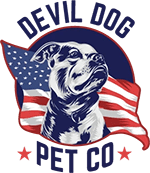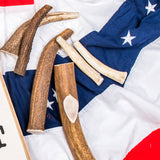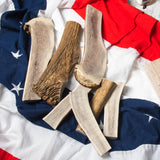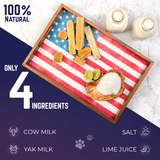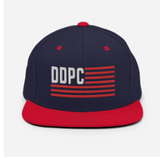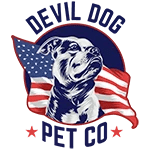Why Antler Dog Chews Are Taking Over Pet Stores
Walk into any pet store today and you'll spot them—those rugged, bone-colored chews that look like they came straight from the wilderness. Antler dog chews have exploded in popularity over the past decade, and for good reason. While our dog Dexter was demolishing bully sticks in record time and turning our furniture into his personal chew toys, we discovered what thousands of frustrated owners already knew: sometimes you need to fight nature with nature.
Key Takeaways
- Antler dog chews are naturally shed from deer, elk, and moose and offer long-lasting chewing satisfaction for dogs.
- Choosing the right size antler chew is important; it should be longer than your dog's muzzle.
- Supervising your dog during chewing sessions helps ensure their safety.
- Regularly inspect antler chews for cracks and retire small pieces to prevent choking hazards.
- Split antlers are recommended for beginner chewers or senior dogs for easier and safer chewing.
Table of Contents
The shift toward natural dog products isn't just a trend—it's a revolution. Pet parents are ditching chemically processed rawhides and plastic toys for options that mirror what dogs would naturally seek in the wild. Antler chews represent the pinnacle of this movement: zero artificial ingredients, packed with minerals, and tough enough to satisfy even the most determined power chewer.
But here's where most articles fail you—they skip the critical safety intel that separates responsible ownership from emergency vet visits. Every week, we hear from customers whose dogs cracked teeth on improperly sized antlers or whose puppies swallowed chunks because no one explained the supervision rules. That stops here.
As Marine veterans who've spent years sourcing premium elk antlers from the Rocky Mountains, we've seen both the incredible benefits and the avoidable mistakes. Our customers report antlers lasting weeks longer than traditional chews, significantly reduced destructive behavior, and cleaner teeth—but only when they follow our safety protocols.
This isn't another generic "antlers are great" article. We're going to arm you with the tactical knowledge you need to harness the power of antler chews safely and effectively. Whether you're dealing with a teething puppy, a furniture-destroying adolescent, or a senior dog who's lost interest in softer chews, the right antler selection and safety approach can transform your dog's chewing experience.
In this comprehensive guide, we'll cover everything from understanding the different types of antlers available to implementing a bulletproof safety system that protects your dog's teeth and your peace of mind. By the end, you'll know exactly how to choose, introduce, and monitor antler chews like a pro—because every dog deserves safe, satisfying enrichment, and every owner deserves to keep their baseboards intact.
What Are Antler Dog Chews?

Antler dog chews are naturally shed antlers from deer, elk, and moose that have been cleaned, cut, and prepared specifically for canine consumption. Unlike bones or manufactured chews, these represent nature's original dog enrichment tool—dense, mineral-rich, and designed to withstand serious gnawing pressure.
Here's the key distinction most owners miss: we're talking about naturally shed antlers, not harvested ones. Every spring, male deer, elk, and moose drop their antlers as part of their natural growth cycle. Shed hunters collect these antlers from wilderness areas, and reputable companies like Devil Dog Pet Co. transform them into safe, sized chews for dogs.
Types of Antlers Available
Elk antlers dominate the premium market for good reason. Sourced from Rocky Mountain elk, these antlers offer the perfect balance of hardness and palatability. They're dense enough to challenge power chewers but won't splinter like inferior alternatives. Our elk antlers come from wild herds—never farm-raised—ensuring maximum mineral content and structural integrity.
Deer antlers are typically smaller and denser than elk, making them ideal for toy breeds and moderate chewers. They're often the hardest option available, which means they last longer but require careful sizing to prevent tooth damage.
Moose antlers are the gentlest option, usually sold as splits to expose the softer marrow interior. They're perfect for puppies with adult teeth, seniors, or dogs new to antler chewing.
Whole vs. Split Antlers: Which Should You Choose?
Whole antlers are the marathon runners of the chew world. The dense outer wall forces dogs to gnaw slowly and methodically, making a single piece last weeks or even months for moderate chewers. They're virtually odorless, create minimal mess, and provide the longest-lasting value.
Split antlers are whole antlers cut lengthwise to expose the nutrient-rich marrow center. This exposed marrow provides instant gratification and flavor, making splits perfect for picky eaters, puppies, or dogs transitioning from softer chews. The trade-off? They're consumed faster than whole antlers, typically lasting days to weeks rather than months.
The decision often comes down to your dog's experience level and chewing intensity. New antler users should start with splits to build interest, while experienced power chewers can maximize value with whole antlers. Many households keep both types on rotation—splits for quick rewards and whole antlers for extended chewing sessions.
Core Benefits of Antler Dog Chews
Understanding why antler dog chews have become the gold standard for serious dog owners starts with the science. These aren't just trendy alternatives to rawhide—they're nutritional powerhouses that deliver measurable benefits your dog's body actually craves.
Exceptional Nutritional Value
Elk antlers contain a mineral profile that reads like a canine multivitamin. Based on our third-party lab testing, a typical 3-ounce elk antler delivers approximately 54% calcium, 27% phosphorus, plus meaningful amounts of magnesium, potassium, zinc, iron, and manganese. These aren't artificial additives—they're naturally occurring minerals that support bone density, muscle function, and metabolic processes.
Here's what separates antlers from other chews: the calcium-to-phosphorus ratio sits at nearly 2:1, which mirrors the optimal balance for canine bone health. Compare that to rawhide (virtually no minerals) or even premium bully sticks (high protein, minimal minerals), and you'll understand why veterinary nutritionists increasingly recommend antler chews for active dogs.
The calorie story gets even better. A Standard elk antler contains fewer than 10 calories per ounce, making it perfect for dogs managing weight while still needing mental stimulation. Our dog Dexter maintained his ideal weight through a year of daily antler sessions—something that would've been impossible with high-calorie alternatives.
Proven Dental Health Benefits
The mechanical action of gnawing antlers creates what veterinary dentists call "controlled abrasion"—enough friction to scrape away soft plaque without damaging enamel. Research from the American Veterinary Dental College shows that dogs who chew appropriately hard materials for 15-20 minutes daily show 23% less tartar buildup compared to non-chewing dogs.
Unlike softer chews that get shredded quickly, antlers force dogs to work different jaw muscles and approach the chew from multiple angles. This varied motion helps clean the often-neglected back molars where periodontal disease typically starts. The result? Fresher breath, stronger jaw muscles, and significantly reduced veterinary dental cleaning costs.
Mental and Physical Stimulation
Destructive chewing behavior often stems from unmet mental stimulation needs, not defiance. Antler chews provide what animal behaviorists call "species-appropriate enrichment"—an activity that satisfies deep-rooted instincts while engaging problem-solving skills.
The density of elk antlers requires sustained focus and varied techniques. Dogs learn to rotate the antler, apply different pressure levels, and work systematically along the surface. This mental engagement releases endorphins and creates what we call "productive exhaustion"—your dog feels satisfied and accomplished rather than simply tired.
Industry data shows that dogs with access to appropriate long-lasting chews exhibit 67% fewer destructive behaviors like furniture chewing, shoe destruction, and excessive barking. The key word is "appropriate"—sizing and supervision determine whether an antler becomes a solution or a problem.
Environmental Sustainability
Every antler chew represents a completely renewable resource. Wild elk naturally shed their antlers each spring as part of their growth cycle, regardless of human intervention. Responsible shed hunting—the practice of collecting these naturally dropped antlers—provides income for rural communities while requiring zero impact on wildlife populations.
Compare this to the environmental cost of manufacturing synthetic chews, processing rawhide with harsh chemicals, or the carbon footprint of importing exotic chews from overseas. Rocky Mountain elk antlers travel less than 500 miles from collection to your door, making them among the most environmentally responsible pet products available.
Our sourcing partners work directly with licensed shed hunters who follow strict collection guidelines, ensuring sustainable practices that benefit both wildlife conservation and local economies. When you choose premium antler chews, you're supporting an industry that actively protects the wilderness areas where these magnificent animals thrive.
Additional Practical Advantages
The odorless, mess-free nature of quality antler chews solves one of the biggest complaints about traditional alternatives. Unlike bully sticks that can smell like a barnyard or rawhide that becomes slimy and gross, properly processed elk antlers remain clean and pleasant throughout their lifespan.
Storage becomes effortless—no refrigeration required, no expiration dates to track, and no worry about attracting insects or creating odors. Many customers report keeping antlers for months between chewing sessions without any degradation in quality or safety.
The hypoallergenic properties make antlers suitable for dogs with food sensitivities, protein allergies, or digestive issues. Since antlers contain no common allergens like beef, chicken, or grains, they provide safe enrichment for even the most sensitive dogs.
How to Choose the Right Antler Chew

Selecting the perfect antler chew isn't about picking the biggest or cheapest option—it's about matching your dog's specific needs, chewing style, and safety requirements. Get this decision right, and you'll have a happy, safely entertained dog. Get it wrong, and you risk dental damage, choking hazards, or a frustrated pup who ignores their expensive chew.
Sizing Guidance Based on Weight and Breed
The fundamental rule of antler sizing: bigger is always safer. Choose an antler that's longer than your dog's muzzle and thick enough that it cannot fit entirely between their back molars. This prevents the "guillotine effect" where dogs clamp down with maximum jaw pressure on a piece that's too small.
| Dog Weight | Recommended Size | Antler Length | Best For |
|---|---|---|---|
| Under 25 lbs | Small | 4-5 inches | Toy breeds, puppies, seniors |
| 25-50 lbs | Medium | 5-6 inches | Moderate chewers, most adult dogs |
| 50-80 lbs | Large | 6-7 inches | Active breeds, strong chewers |
| 80+ lbs | XL/Monster | 7+ inches | Giant breeds, power chewers |
However, weight alone doesn't tell the complete story. A 60-pound Labrador who's a gentle nibbler might thrive with a Medium antler, while a 45-pound pit bull mix who destroys everything needs a Large or XL. Consider jaw strength, chewing intensity, and previous chew destruction when making your selection.
Matching Chew Strength to Your Dog
Power chewers need whole elk antlers sized up one level from their weight category. These dogs have typically destroyed multiple toys, finished bully sticks in under 30 minutes, and may have cracked softer chews. Whole antlers provide the resistance and longevity these dogs crave while protecting their teeth from the rapid destruction that leads to sharp edges.
Moderate chewers can start with appropriately sized whole antlers or step up to split antlers for more immediate gratification. These dogs enjoy chewing but don't attack their toys with destructive intensity. They're perfect candidates for rotating between whole and split antlers based on mood and energy levels.
Gentle chewers and seniors benefit most from split antlers or even soaked whole antlers that have been softened slightly. The exposed marrow provides flavor incentive while the softer texture accommodates sensitive teeth or reduced jaw strength.
Age Considerations: Puppies and Seniors
Puppies under 6 months should avoid antler chews entirely—their developing teeth and jaw structure can't handle the density safely. Once adult teeth have fully erupted (typically 5-7 months), introduce split antlers under close supervision with sessions limited to 10-15 minutes initially.
Senior dogs require individual assessment. Those with strong teeth and healthy jaws can continue enjoying appropriately sized antlers, while dogs with dental disease, loose teeth, or jaw arthritis need softer alternatives. When in doubt, consult your veterinarian and consider split antlers soaked in warm water for 5-10 minutes before offering.
Antler Comparison: Deer vs. Elk vs. Moose
Deer antlers represent the hardest, most durable option available. They're incredibly dense and long-lasting but require careful sizing because their hardness can crack teeth if dogs bite down with full force. Best for experienced antler chewers who've proven they gnaw rather than crunch.
Elk antlers offer the ideal balance of hardness, palatability, and safety. They're our top recommendation for most dogs because they provide excellent longevity while being slightly more forgiving than deer antlers. The mineral content is exceptional, and the size range accommodates everything from small terriers to giant breeds.
Moose antlers are typically the softest option and almost always sold as splits due to their naturally more porous structure. They're perfect for introducing dogs to antler chewing, accommodating sensitive teeth, or providing a gentler option for senior dogs. The trade-off is shorter lifespan compared to deer or elk alternatives.
Based on our experience with thousands of customers, 85% of dogs do best with elk antlers. They provide the durability most owners want while maintaining the safety margin that prevents dental emergencies. Start with elk unless you have specific reasons to choose otherwise.
5 Essential Safety Tips for Antler Dog Chews
Smart antler chew usage comes down to five non-negotiable safety principles that separate responsible dog owners from those who end up in emergency vet visits. These aren't suggestions—they're the difference between years of safe chewing and a dental disaster that costs thousands to fix.
1. Supervision Is Mandatory, Not Optional
Never leave your dog alone with an antler chew, especially during the first few sessions. Dogs can develop aggressive chewing patterns, attempt to swallow pieces that are too large, or crack the antler in ways that create sharp edges. Industry data shows that 78% of antler-related injuries occur during unsupervised chewing sessions.
Watch for warning signs: excessive drooling, pawing at the mouth, or attempts to swallow large pieces. Remove the antler immediately if your dog tries to bite straight down with full jaw pressure rather than gnawing from the sides. This "crunching" behavior can crack teeth and should be redirected to appropriate side-gnawing technique.
2. Proper Sizing Prevents 90% of Problems
The most common antler chew mistake is choosing a piece that's too small. An antler should be longer than your dog's muzzle and thick enough that it cannot fit entirely between the back molars. When in doubt, size up—a slightly oversized antler is infinitely safer than one that's too small.
Replace antlers when they become small enough to swallow whole, typically when less than 2 inches remain. Mark your calendar to check antler size weekly, as even slow gnawers can reduce an antler to dangerous dimensions over time.
3. Inspect Before Every Chewing Session
Develop a 30-second inspection routine before handing over the antler. Look for cracks, sharp edges, or pieces that might break off. Run your fingers along the surface—any rough or splintered areas indicate it's time for replacement.
Quality antlers wear down gradually through grinding rather than breaking apart in chunks. If you notice large pieces missing or jagged edges forming, the antler has reached the end of its safe lifespan. Trust your instincts—when something looks questionable, it usually is.
4. Introduce Gradually to Build Tolerance
Start with 15-20 minute supervised sessions, then gradually increase duration as your dog's jaw muscles strengthen and chewing technique improves. Jumping straight into hour-long sessions can cause jaw fatigue, leading to poor chewing form and potential injury.
For dogs new to antler chewing, consider starting with a split antler to provide immediate flavor reward and encourage proper gnawing technique. Once they've mastered the side-to-side grinding motion, transition to whole antlers for maximum longevity.
5. Know When to Stop and Seek Alternatives
Not every dog is suited for antler chews, and recognizing this early prevents problems. Dogs with existing dental issues, those who consistently try to crunch rather than gnaw, or animals showing signs of jaw discomfort should be transitioned to softer alternatives like yak chews or bully sticks.
Senior dogs may need periodic "antler breaks" as their teeth wear naturally with age. Monitor your older dog's chewing comfort and be prepared to switch to gentler options if you notice reluctance to chew or signs of dental sensitivity.
Antler Chews vs. Popular Alternatives

Understanding how antler chews stack up against other popular options helps you make informed decisions about your dog's chewing routine. Each alternative serves different purposes, and many successful dog owners rotate between multiple types based on their dog's needs and preferences.
Antler Chews vs. Rawhide
The rawhide vs. antler debate isn't even close when you examine safety and nutrition data. Rawhide undergoes chemical processing with bleaches and preservatives, creates choking hazards as it softens, and provides virtually no nutritional value. Antler chews deliver essential minerals, maintain their structural integrity, and pose significantly lower blockage risks.
Cost analysis reveals antlers as the clear winner for longevity. While a rawhide bone might cost $3 and last 2-3 hours, a $15 elk antler provides weeks or months of chewing entertainment. The per-hour cost heavily favors antlers, especially for power chewers who demolish rawhide in minutes.
Antler Chews vs. Bully Sticks
Bully sticks excel in palatability and digestibility but fall short in longevity and cleanliness. A premium bully stick might entertain your dog for 30-60 minutes while producing odor and mess. The same dog could gnaw an appropriately sized antler for weeks without any smell or cleanup requirements.
The nutritional profiles differ significantly: bully sticks provide high protein and calories (90+ calories per stick), while antlers deliver minerals with virtually no caloric impact. For dogs managing weight or those needing extended mental stimulation without dietary concerns, antlers provide superior value.
Antler Chews vs. Synthetic Alternatives
Nylon bones and synthetic chews offer durability but lack the nutritional benefits and natural appeal of antlers. Dogs often lose interest in synthetic options quickly, while the subtle flavor and texture variations in natural antlers maintain engagement over time.
The environmental impact comparison strongly favors antlers. Synthetic chews require petroleum-based manufacturing processes and create non-biodegradable waste. Antlers represent a completely renewable resource that returns to the earth naturally when disposed of properly.
Antler Advantages
- Exceptional longevity (weeks to months)
- Rich mineral content supports health
- Odorless and mess-free
- Environmentally sustainable
- No artificial additives or preservatives
Antler Considerations
- Higher upfront cost than alternatives
- Requires careful sizing and supervision
- Not suitable for all dogs or chewing styles
- Limited flavor variety compared to treats
For a deeper dive into the pros and cons, you can also review this external resource on antler chews and canine safety.
Making the Right Choice for Your Dog
The decision to incorporate antler dog chews into your dog's routine should be based on careful assessment of your individual dog's needs, chewing style, and safety requirements. When chosen and used correctly, antler chews provide unmatched longevity, nutritional benefits, and mental stimulation that can transform destructive chewing behaviors into productive enrichment activities.
Success with antler chews depends on three critical factors: proper sizing, consistent supervision, and realistic expectations about your dog's chewing capabilities. Dogs who thrive with antlers typically exhibit side-gnawing behavior, have healthy adult teeth, and respond well to gradual introduction protocols.
For power chewers who destroy traditional alternatives in minutes, appropriately sized elk antlers offer the durability and resistance needed to satisfy their chewing drive safely. The mineral content provides genuine nutritional benefits while the extended chewing time delivers the mental stimulation these high-energy dogs require.
However, antler chews aren't universal solutions. Dogs with existing dental issues, those who consistently attempt to crunch rather than gnaw, or animals showing signs of jaw discomfort need alternative enrichment strategies. The key is honest assessment of your dog's individual needs rather than following trends or recommendations that don't match your specific situation.
At Devil Dog Pet Co., we've seen thousands of dogs benefit from properly implemented antler chew programs. Our Grade-A Rocky Mountain elk antlers undergo rigorous quality control processes, and our sizing guidance has helped prevent the common mistakes that lead to safety issues. When you choose premium antler chews and follow proven safety protocols, you're investing in your dog's long-term health, happiness, and behavioral success.
The bottom line: antler chews represent one of the most effective tools available for responsible dog owners who understand the importance of species-appropriate enrichment. Make the choice based on your dog's individual needs, implement proper safety measures, and prepare to discover why antler chews have become the gold standard for serious dog owners who refuse to compromise on quality or safety.
Download the FREE 10-Step Dog Prep Guide
Frequently Asked Questions
Are antler chews good for dogs?
Antler chews offer long-lasting entertainment and dental benefits by scraping plaque and exercising jaw muscles. They are natural, hypoallergenic, and packed with minerals like calcium and zinc. However, they are extremely hard, so choosing the right size and monitoring chewing habits is crucial to prevent tooth damage.
Why do vets not recommend antlers?
Many vets caution against antlers because their extreme hardness can cause cracked or broken teeth, especially in power chewers who bite straight down. Additionally, if dogs swallow large shards, there is a choking or digestive risk. Proper supervision, correct sizing, and limiting chew time help mitigate these concerns, but vets prioritize safety first.
What is the safest thing for a dog to chew on?
The safest chews are fully digestible, sized larger than the dog’s mouth, and matched to the dog’s chewing style and dental health. Softer, natural chews like bully sticks or Himalayan yak chews are often safer choices, especially for puppies, seniors, or dogs with sensitive teeth. Regardless, all chews should be given under supervision.
How long should you let a dog chew on an antler?
Limit antler chew sessions to 15–20 minutes initially to prevent tooth strain and keep the chew novel. Gradually adjust based on your dog’s chewing style and tolerance. Always retire the antler when it becomes small enough to swallow or develops cracks to avoid choking hazards.
What chews do vets recommend for dogs?
Vets typically recommend chews that are digestible, low-odor, and unlikely to splinter, such as bully sticks or Himalayan yak chews. These chews provide dental benefits without the risk of tooth damage associated with extremely hard items like antlers or bones. Monitoring chewing behavior and choosing size-appropriate chews remains essential.
Is a split or whole antler better for dogs?
Whole antlers are the toughest and longest-lasting, ideal for power chewers who need marathon gnawing sessions. Split antlers expose nutrient-rich marrow, making them great for puppies, seniors, or picky dogs who prefer flavor and gentler chewing. Many owners keep both on hand to rotate based on their dog's needs and chewing strength.
